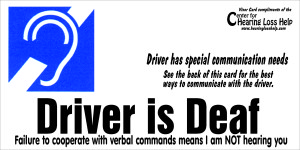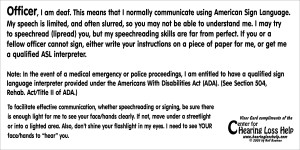 The purpose of the Visor Card is to bridge the initial communications gap with the police if you are ever stopped by them. It lets the police know you can’t hear/understand their orders and instructions. As a result, they will have to use alternate communication strategies including hand signals, writing things down and use ASL to sign to you.
The purpose of the Visor Card is to bridge the initial communications gap with the police if you are ever stopped by them. It lets the police know you can’t hear/understand their orders and instructions. As a result, they will have to use alternate communication strategies including hand signals, writing things down and use ASL to sign to you. 
There are two versions of the Visor Card. The Deaf Visor Card (shown here) is for people who are culturally deaf—that is, they identify with the Deaf community and use ASL as their primary means of communication, rather than speech.
(The Hard of Hearing Visor Card is for people who identify with the hearing community—that is, they use their voices to speak, read and write English fluently and often speechread and wear hearing aids. To learn more about the Hard of Hearing Visor Card, or to purchase it, click here.)
You can learn more about the reasons for using the Deaf Visor Card and download a free copy of the Deaf Visor Card here, or you can purchase a Deaf Visor Card Pak already made up. The Deaf Visor Card Pak includes:
- Laminated “Driver is Deaf” Visor Card
- Laminated Wallet Deaf Card
- Brochure: “Visor Cards: Bridging the Communications Gap When Stopped by the Police” including instructions how to use your Deaf Visor Cards. You can also download this full-color 4-page Visor Card Brochure here.
Order your Deaf visor card pak now for just $6.95.
Correctly Placing Your Visor Cards
Your Visor Cards are useless unless they are instantly available whenever you need them. You don’t want to have to rummage around in the glove box or under the seat when you are pulled over. (Police officers may think you are reaching for a gun and act accordingly.)
The Visor Card is called a visor card for good reason. You attach it to your sun visor. That way, it is normally out of sight, yet instantly available when needed.
Here’s how to mount it. Fold down your sun visor. Place the Visor Card on your sun visor—right side up facing you when your visor is down. Hold it in place with two elastic bands around both the Visor Card and sun visor.
With the sun visor up, your Visor Card is hidden out of sight so you are not advertising the fact that you are deaf, but it is in place, ready for instant use whenever you need it.
Correctly Using Your Visor Cards
If you are ever stopped by the police, follow these steps in this order.
- Pull over and stop safely. (If it is dark and you are able to, stop under a street lamp, or pull into a lighted parking area. This will make it easier for you to speechread.)
- Immediately flip your sun visor down, unhook the end by the rear-view mirror, and swing it over so your Visor Card is clearly visible in the driver’s side window. If you have two visor cards and you think a police officer will come to the passenger side, deploy that visor too. Even better, deploy both visor cards every time you are stopped. That way, you have your bases covered, no matter what happens.
- Open your driver’s side window all the way. (Police officers get very nervous with today’s dark windows!) Also open the passenger’s-side window if you flipped that visor down as well.
- If it is dark, turn on your dome light.
- Place both of your hands on the steering wheel well before any police officer approaches your vehicle. Police officers want to see both your hands at all times. The safest place is to put them on the wheel at the standard driving positions of 10 o’clock and 2 o’clock. Keep your hands on the wheel until after you establish effective communication with the police officer.
Have the officer remove your Visor Card and read the instructions on the back so he knows how to effectively communicate with you. That’s all there is to it!
You may never have to use your visor cards, but if you ever do get pulled over, you are prepared. You can “hang loose” and let your Visor Cards do the work of bridging the initial communications gap with the police.